Tall Palm Trees (With Pictures) – Identification Guide
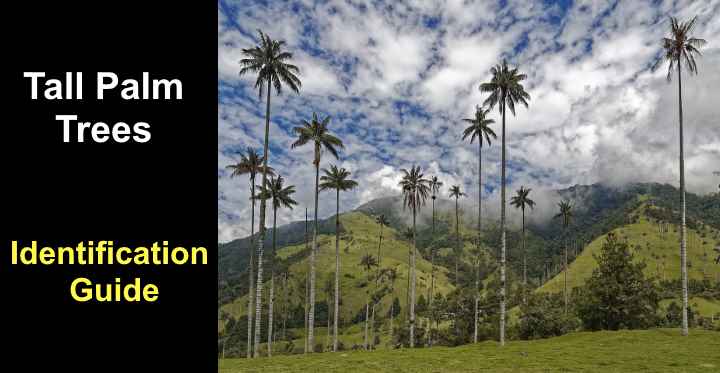
Tall palm trees symbolize tropical and subtropical regions. The Quindío wax palm, the world’s tallest, grows up to 200 feet (60 m). Many other palms reach 100 feet (30 m) in height. These majestic tropical trees grace skylines with their tall, slender trunks and fan-like or feather-like fronds.
Whether you want to add a touch of the tropics to your garden or admire these towering giants, this identification guide will help you recognize some of the most common tall palm trees.
Types of Tall Palm Trees — With Pictures and Descriptions
Here is an identification guide to the different types of tall palm trees, complete with pictures and descriptions.
Quindío Wax Palm (Ceroxylon quindiuense)
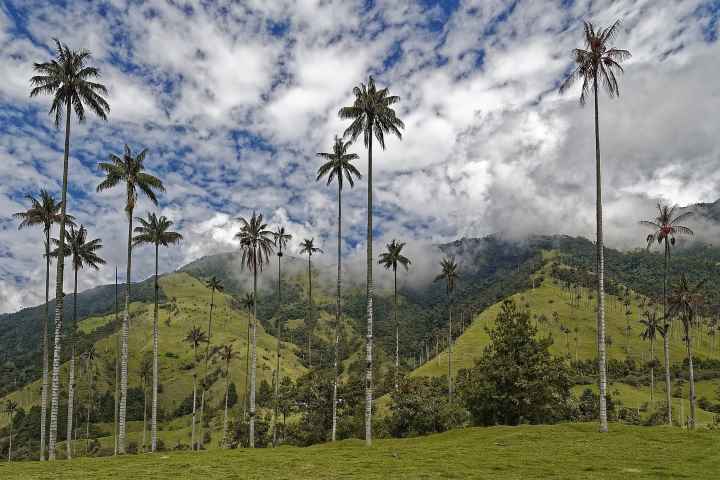
Quindío wax palm is the tallest palm in the world and can be found in the warmest zones in USA
The Quindío wax palm is the tallest palm species in the world, reaching heights of 200 ft. (60 m). The tall, slender palm tree is identified by its gray trunk with prominent diamond-shaped leaf scars and covered in a thick wax layer. The Quindío wax palm leaves are large feather-like fronds measuring 6 to 18 ft. (1.8 – 5.5 m) long.
Quindío wax palm flowers are dense clusters of creamy white blossoms. These give way to small, round fruits that emerge green and turn black as they mature.
This sun-loving plant thrives in warm climates in USDA zones 10 and 11. The tallest palm trees in the world are native to the Andes of Colombia and are found in elevations between 6,000 and 10,000 ft. (2,000 to 3,000 m). In North America, you can see Quindío wax palms in parks in California.
Coconut Palm Tree (Cocos nucifera)
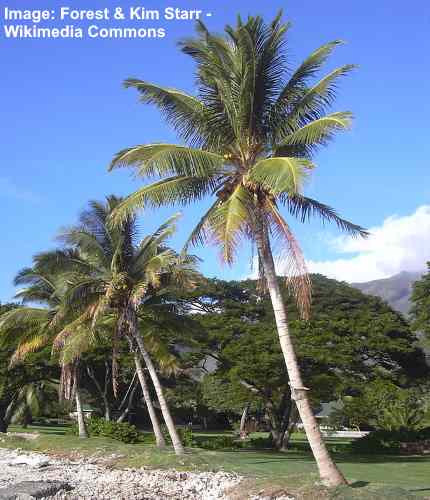
The coconut palm tree can grow very tall and thrives in warm tropical conditions
The coconut palm tree is a tall, slender palm tree growing up to 100 ft. (30 m). The tall palm has a straight, cylindrical brown trunk crowned by feather-like fronds. These arching palm leaves form a dense canopy and grow 15 to 20 ft. (4.5 – 6 m) long. The identifying feature of Cocos nucifera is its large clusters of coconuts.
Coconut palm trees thrive in warm, sunny climates. The tall palms are popular landscaping trees in residential yards, streets, parks, and coastal areas. The resilient palms grow in poor, sandy soil and withstand strong winds and salt spray.
Coconut palm trees are suitable for growing in USDA zones 10 through 12.
Royal Palm (Roystonea regia)
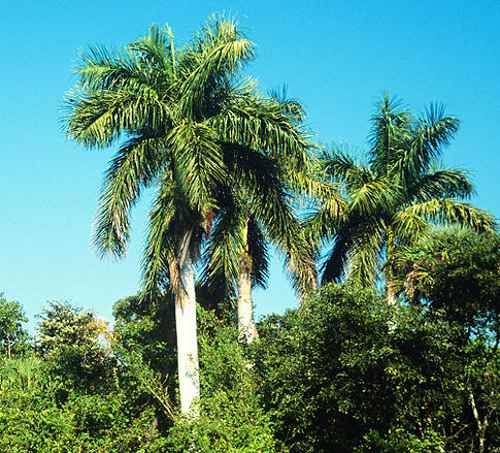
The native Florida royal palm is a tall ornamental tree suitable for the warmer parts of USA
At 100 ft. (30 m) tall, the royal palm is one of the tallest palms native to Florida. The ornamental feature of this palm tree is its huge feathery fronds that grow 10 to 15 ft. (3 – 4.5 m) long. The fronds are bright green and form a crown above the bright green crown shaft.
The stately royal palm tree grows 60 to 100 ft. (18 – 24 m) tall. The lofty palm is a common sight in Florida and California, where it’s planted to landscape streets, driveways, and parks. Its tolerance to drought and sea spray makes it an ideal landscaping tree in tropical regions.
The royal palm is suitable for planting in USDA zones 10 and 11.
Related reading: Small Florida palm trees.
Date Palm (Phoenix dactylifera)
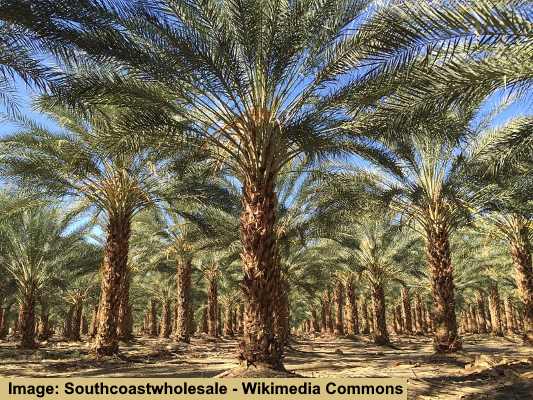
Date palm trees are very tall and produce delicious fruit
Date palm is a tall, sun-loving, drought-tolerant palm tree that towers around 80 ft. (24 m) tall. Perfect for warm climates, the palm tree produces sweet, edible palm fruits. Its characteristics are enormous feather-like fronds arching gracefully at the top of a slender trunk. The fronds measure 10 to 16 ft. (3 – 5 m).
Vertically impressive date palm trees add a tropical touch to landscapes. The date palm tree grows 50 to 80 ft. (15 – 24 m). Its large crown consists of 100 to 200 fronds. The date palm tree grows in most soil types that are well-drained. Hot sunny weather is necessary for excellent fruit production.
Date palm trees thrive in USDA zones 9 to 11.
Mexican Fan Palm (Washingtonia robusta)
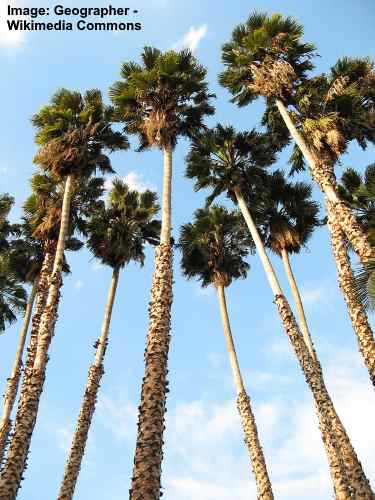
The Mexican palm tree has tall and skinny trunk with fan-shaped fronds
Mexican fan palm is a fast-growing palm tree that reaches impressive heights of 80 ft. (24 m). The ornamental feature of this palm tree is its stunning fan-shaped leaves that grow 3 to 5 ft. (1 – 1.5 m) long. Old fronds droop against the trunk forming an identifiable skirt.
Also called the skyduster or thread palm, the tropical plant grows 50 to 80 ft. (15 – 24 m) tall. The towering palm also has huge sprays of white flowers followed by small pea-like palm fruits.
Mexican fan palms are drought-tolerant and require little maintenance. They perform best in full sun and well-draining soil. Its tolerance to salty air and high winds makes it popular for planting near coastlines.
Mexican fan palms are suitable for growing in USDA zones 9 through 11.
Canary Island Date Palm (Phoenix canariensis)
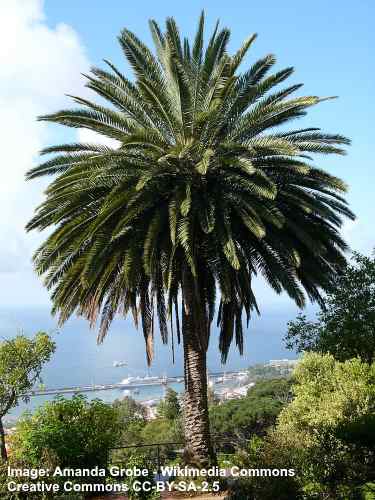
The beautiful Canary Island palm tree has a tall trunk with large feathery fronds
The Canary Island date palm is a majestic palm tree with a towering presence. The tropical palm tree grows 40 to 60 ft. (12 – 18 m) tall. Identifying features of the fruit-producing palm are its thick trunk covered with diamond-shaped leaf scars, pinnate feather fronds, and yellow dates.
The date palm’s fronds measure up to 20 ft. (6 m) long. Its trunk can grow 3 ft. (1 m) across, and its sweet, juicy fruits are 1” (2.5 cm) long.
Canary Island date palm trees are popular ornamental trees in warm temperate climates. Surprisingly cold-hardy, the palm tree can withstand temperatures as low as 18°F (-8°C). Its jaggy trunk and crown of arching fronds make it one of the most recognizable tall palms in the world.
Canary Island date palm grows in USDA zones 9 to 11 and prefers well-drained soil and full sun.
Bismarck Palm (Bismarckia nobilis)

The slow-growing Bismarck palm tree has beautiful silvery gray foliage and can grow tall after many years
The Bismarck palm is one of the most attractive tall palm trees growing around 70 ft. (21 m) in height. The easily recognizable feature of the towering palm is its spreading crown of huge fan-like fronds. Each palm leaf measures 4 ft. (1.2 m) long and wide. The slow-growing palm also produces clusters of large brown fruits.
The impressive Bismarck palm has excellent dry heat and drought tolerance, making it ideal for landscaping tropical gardens. In USDA zones 10 and 11, it’s a popular palm in lawns, along driveways, and parks. Additionally, it’s tolerant of salt spray, meaning it’s ideal for beachfront properties.
California Fan Palm (Washingtonia filifera)
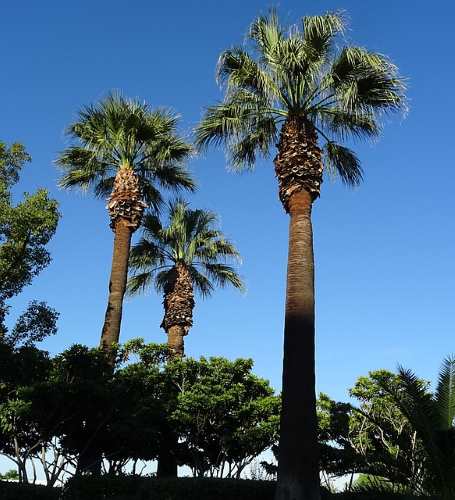
The ornamental California fan palm is identified by its tall trunk and fan shaped fronds
The California fan palm is a relatively tall palm tree native to the western United States. The sun-loving palm tree grows 40 to 60 ft. (12 – 18 m) tall. Its identifying features are fan-shaped fronds, a dense shaggy skirt below the crown, and huge sprays of creamy-white flowers followed by small black fruits.
Also called the petticoat palm, the exotic California fan palms are easily identified in tropical climates. The sturdy, columnar trunk has a huge crown of arching fan leaves. It has tremendous ornamental value for landscaping large outdoor spaces in warm, dry climates.
The tall, stately palm tree is one of the largest native palms in North America.
California fan palms are suitable for growing in USDA zones 8 to 11.
Caranday Palm (Copernicia alba)

The tall Caranday palm is identified by its slender and smooth trunk and fan-shaped leaves
The Caranday palm is a tall palm tree that reaches heights of 35 to 40 ft. (10.5 – 12 m). The tall, slender palm tree has a dense crown of fan-shaped leaves at the top of an erect, smooth trunk. The silver-gray leaves grow 5 ft. (1.5 m) long.
The Caranday palm produces small, white, or creamy-white flowers in spring. These are followed by small black fruits in summer. This showy, versatile palm tree tolerates drought and wet soil conditions. It’s also heat-hardy and thrives in tropical landscapes. It’s the cold-hardiest palm tree in the genus Copernicia.
The Caranday palm is suitable for planting in USDA zones 9 through 11.
Alexander Palm (Archontophoenix alexandrae)
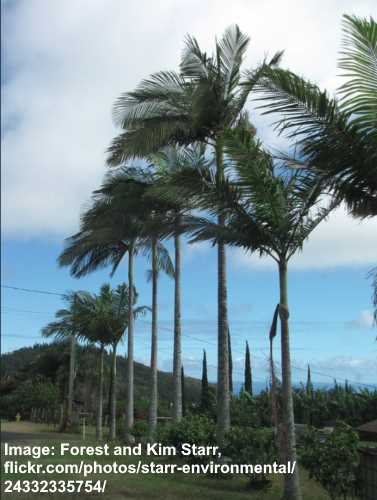
Alexander palm is a tall tree with a slender trunk suitable for tropical landscapes
The Alexander palm is a tall, elegant palm tree that reaches 100 ft. (30 m) in height. The tall palm’s impressive feature is its graceful crown of feathery fronds that reach up to 15 ft. (4.5 m) long. Each frond has between 120 and 180 leaflets, which are dark green with silvery undersides.
The Alexander palm is a stunning landscaping palm tree for tropical regions. The solitary palm looks attractive when planted in groups along driveways or as a focal point in a garden. Its salt spray and coastal wind tolerance make it an ideal addition to seaside gardens. You can grow the palm in smaller gardens in containers if space is limited.
The Alexander palm is suitable for growing in USDA zones 10 and 11.
Sugar Palm (Arenga pinnata)

The tall sugar palm is salt and wind tolerant and is suitable for tropical coastal regions
The sugar palm is a large, tropical palm tree that grows up to 70 ft. (21 m) tall. The ornamental features of this palm tree are its large, fan-shaped leaves that grow up to 40 ft. (12 m) long. The impressive palm produces clusters of small, yellowish-green flowers followed by small, edible fruits.
Native to Southeast Asia, the sugar palm thrives in full sun or partial shade in fertile, well-drained soil. It is suitable for planting as a specimen tree or in groups. The palm tree is also ideal for coastal gardens, as it is salt-tolerant and can withstand strong winds.
Sugar palm is suitable for planting in USDA zones 10 and 11.
African Fan Palm (Borassus aethiopum)
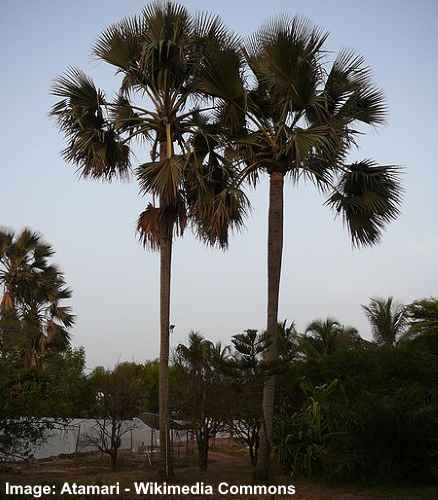
The African fan palm is a tall majestic tree that is a focal point in tropical gardens
The tall African fan palm grows to an impressive 82 ft. (25 m) in height. Identifying features of the palm tree are its fan-shaped leaves 10 ft. (3 m) long, a thick cylindrical trunk with a deeply grooved texture, and clusters of large yellow flowers and yellowish edible fruits.
African fan palms are ideal for planting in warm, sunny climates. Its eye-catching crown of bluish-green fan leaves creates a captivating centerpiece. Also, its exotic silhouette adds a focal point to tropical landscapes. The palm tree also produces tasty fruits.
African fan palms are suitable for growing in USDA zones 10 and 11.
American Oil Palm (Attalea butyracea)
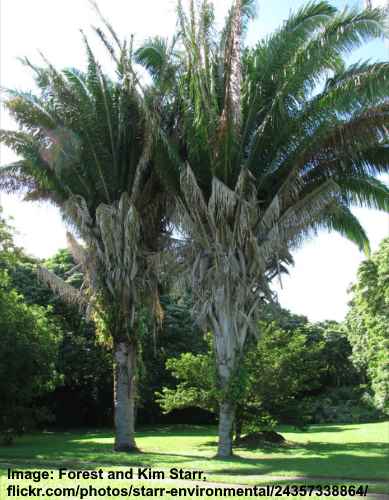
The tall American oil palm has impressive crown and looks stunning in tropical landscapes
The American oil palm tree is a tall tropical palm tree that reaches 82 ft. (25 m) tall. The palm tree has large, feather-like leaves that grow 20 ft. (6 m) long and 3 ft. (0.9 m) wide. Up to 35 arching leaves form the impressive crown at the top of its straight, cylindrical, unbranched trunk.
The American oil palm is a stunning landscape palm for large landscapes, parks, and gardens. The palm tree is suitable for planting in USDA zones 10 and 11.
Canala Palm (Kentiopsis oliviformis)

In the picture: a young Canala palm tree
The Canala palm tree is an impressively tall palm tree that grows over 100 ft. (30 m) tall. Native to South Pacific islands, the palm has an arching crown of long, feather-like fronds measuring 10 ft. (3 m) long. The stately palm also produces large clusters of palm fruits hanging below the crown.
This Canala palm tree is ideal for planting in warm, humid climates and is known for its stunning appearance. It’s ideal for poolside plantings, tropical gardens, and as a specimen plant.
The Canala Palm is suitable for planting in USDA zones 10 and 11.
Bay-Leaf Palm (Sabal mauritiiformis)
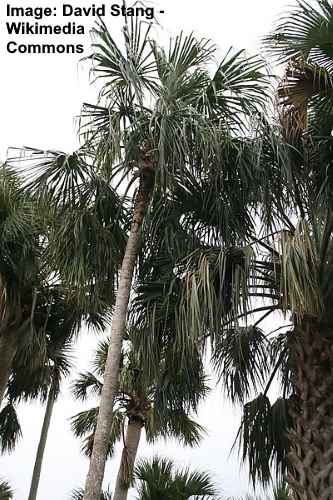
The bay-leaf palm is a slow growing tall tree with fan-shaped fronds
Bay-leaf palm is a slow-growing, sun-loving palm tree that reaches 65 ft. (20 m) in height. The identifying features of the palm are its slender trunk, fan fronds that create an impressive irregular crown, and pear-shaped black fruits. Around 10 to 25 fronds make up the crown.
Bay-leaf palm thrives in full sun and well-drained soil. It’s an excellent choice for planting as a specimen tree, accent plant, or in groups to create a tropical landscape. The palm tree is also drought tolerant and requires little maintenance once established.
Bay-leaf palm is suitable for growing in USDA zones 9 through 11.
Queen Palm (Syagrus romanzoffiana)
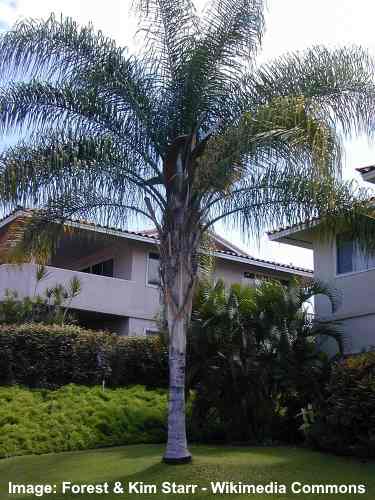
The Queen palm is a popular ornamental tree that reaches tall height
The queen palm is a stunning tropical palm tree with an impressive height of up to 80 ft. (24 m). The tall, slender trunk has rings from old leaf bases. The eye-catching crown comprises feather-like fronds 13 ft. (4 m) long. The arching fronds spread out horizontally, giving the palm tree a distinctive appearance.
The queen palm tolerates salt, drought, and high heat, making it ideal for planting in warm, coastal areas. The beautiful palm tree has tremendous ornamental value and enhances any tropical garden landscape.
The queen palm is suitable for growing in USDA zones 9 through 11.
Cabbage Palm (Sabal palmetto)
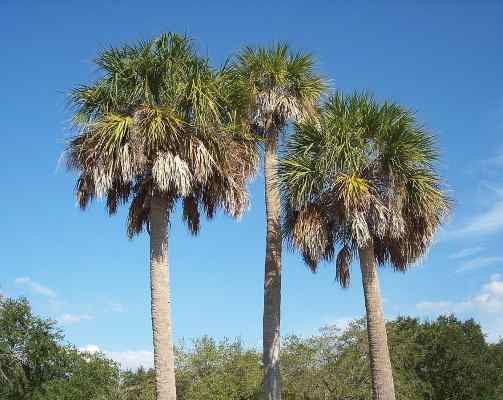
The tall cabbage palm is common in coastal areas in Southeastern USA
The tall cabbage palm is an elegant tree that grows 50 ft. (15 m) tall. The sun-loving palm tree has a distinctive look thanks to the shaggy skirt of dead fronds. The palm tree has a solitary, tall trunk that is gray and smooth at the base. The large fan-shaped leaves grow 6 ft. (1.8 m) long, creating a somewhat compact, slender crown.
The cabbage palm is native to Florida and the Southeastern US. It is a common sight in coastal areas. The palm’s ornamental value makes it popular along streets, in parks, or to enhance a large residential garden.
The cabbage palm is the state tree of Florida, and it also appears in South Carolina’s state flag. The tall palm tree is suitable for planting in USDA zones 8 through 11.
Schattauer’s Loulu Palm (Pritchardia schattaueri)
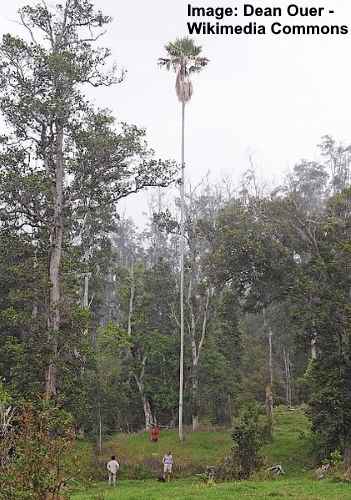
The Schattauer’s Loulu palm, native to Hawaii, grows to impressive heights.
Schattauer’s Loulu Palm is a tall and rare palm tree native to Hawaii that grows an impressive 130 ft. (40 m) high. This palm tree has large fan-like fronds that grow 6 ft. (1.8 m) long and 7 ft. (2.1 m) wide. This distinctive palm tree has dead fronds, creating a skirt-like feature under the crown. Additionally, its trunk has a diamond-shaped pattern created by the leaf scars.
Schattauer’s Loulu palm is suitable for growing in USDA zones 10 to 12.
Chilean Wine Palm (Jubaea chilensis)
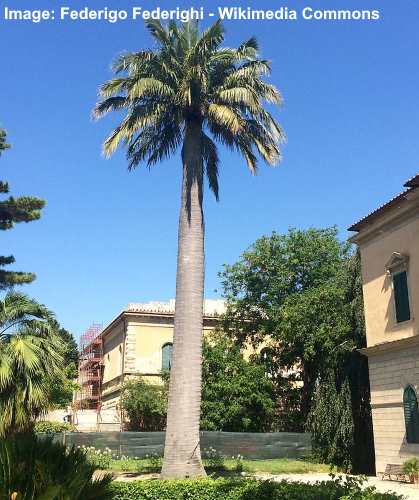
The tall Chilean wine palm has massive trunk and is cold hardy
The Chilean wine palm is a slow-growing tall palm tree that can reach a height of 80 ft. (24 m) or more. The ornamental features of this palm tree are its massive ringed trunk, upward spreading crown, and arching feather-like fronds that measure 15 ft. (4.5 m).
Many rate the Chilean wine palm as one of the most impressive palms in the world. It’s suitable for planting in large landscapes, parks, and estates. The palm tree is cold-hardy to 15°F (-9°C), tolerating drought, moist winters, and frost.
Chilean wine palm is suitable for planting in USDA zones 8 through 11.
Related articles:
